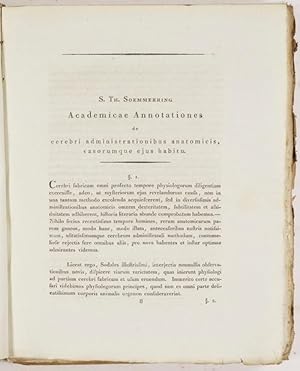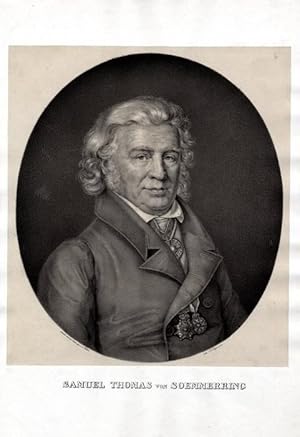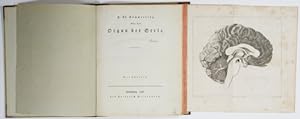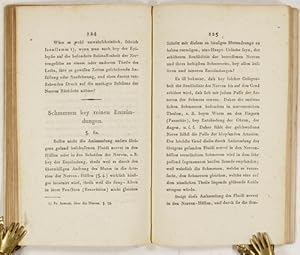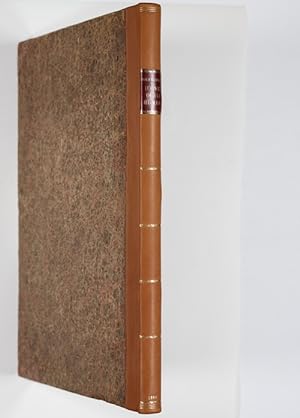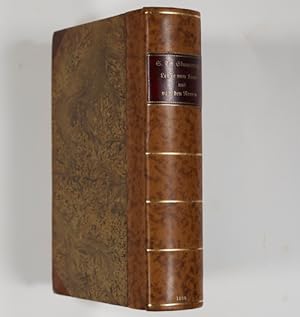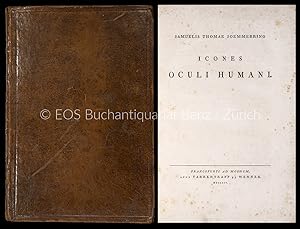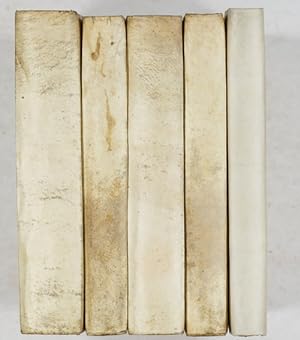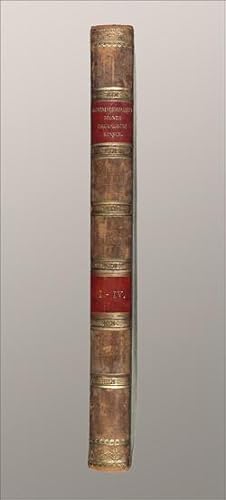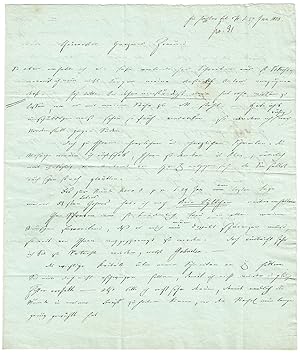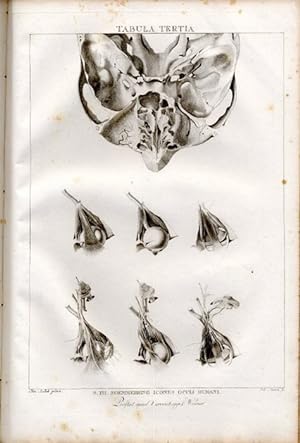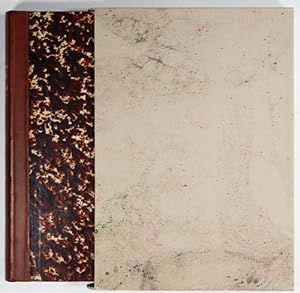SOEMMERRING, SAMUEL THOMAS V (32 resultados)
Tipo de artículo
- Todo tipo de artículos
- Libros (28)
- Revistas y publicaciones
- Cómics
- Partituras
- Arte, grabados y pósters (3)
- Fotografías
- Mapas
-
Manuscritos y
coleccionismo de papel (1)
Condición
- Todo
- Nuevos
- Antiguos o usados
Encuadernación
Más atributos
- Primera edición (11)
- Firmado (1)
- Sobrecubierta
- Con imágenes del vendedor (21)
- Sin impresión bajo demanda
Ubicación del vendedor
Valoración de los vendedores
-
Werke. 6.Bd.: Schriften zu den Sinnesorganen: Auge.
Año de publicación: 1994
Librería: Antiq. F.-D. Söhn - Medicusbooks.Com, Marburg, Alemania
Libro
Stuttgart, Jena, New York, Gustav Fischer Verlag, 1994, 4°, (8), 322 pp., 66 Abbildungen, orig. Leinenband.
-
Portrait, Brustbild nach vorne, gemalt von Tellot; Lichtdruck.
Año de publicación: 1899
Librería: Antiq. F.-D. Söhn - Medicusbooks.Com, Marburg, Alemania
Arte / Grabado / Póster
Das 19. Jhdt. Bildniss., 198. - Hrsg. v. Karl Werckmeister. - Berlin, Kunstverlag der Photographischen Gesellschaft, 1899, 265 x 360 mm. Samuel Thomas Soemmerring, seit 1808 Ritter von Soemmerring, auch Sömmerring (1755-1830), Anatom, Anthropologe, Paläontologe und Erfinder. Soemmerring entdeckte 1791 den "gelben Fleck" in der Netzhaut des menschlichen Auges. Seine Untersuchungen über das Gehirn und das Nervensystem, über die Sinnesorgane, über den Embryo und dessen Fehlbildungen, über den Bau der Lungen, über die Eingeweidebrüche usw. machten ihn zu einem der bedeutendsten deutschen Anatomen. In späteren Jahren verlagerte er seine Arbeitsgebiete auf die Physik, Chemie und Paläontologie. 1809 entwickelte er einen elektrochemischen Telegraphen.
-
The Life and Work of Samuel Thomas von Sömmerring (pp.369-386, Fig.).
Año de publicación: 1924
Librería: Antiq. F.-D. Söhn - Medicusbooks.Com, Marburg, Alemania
Libro
Ann. med. Hist., 6/4. - New York, Paul B. Hoeber, December 1924, Gr.8°, (4) pp.363-496, (8), Frontispiece Portrait of Sömmerring, orig. wrappers.
-
Ueber das Organ der Seele.
Año de publicación: 1796
Librería: Antiq. F.-D. Söhn - Medicusbooks.Com, Marburg, Alemania
Libro
Reprint 1966. - Königsberg: Nicolovius, 1796, 8°, VIII, 87 pp., 3 Kupferstichtafeln, orig. Leinenband. Samuel Thomas Soemmerring (1755-1830) was a late believer in the ancient notion that man"s soul was housed in the cerebrospinal fluid. In his treatise on "the organ of the soul", he speculated that the soul-force (Seelenkraft) exerted its action at the place where the fluid from the ventricles met the terminals of the nerves. This hypothesis, based on the ideas of Naturphilosophie did not find favor; however, the anatomical portion of Soemmering"s treatise-- particularly his assertion that the cranial nerves originate (or terminate) in the ventricular wall--was well received." Norman "The first two plates represent an excellent, and even today the best view of a profile cross-section of the brain utterly different from the one presented in (Soemmerring"s) inaugural dissertation. The last plate represents the fourth ventricle of the brain opened from above and from behind." Choulant (1853), p 306. The work is dedicated to Immanuel Kant who povided the epilogue, pp. 81-86. Frist Edition: Blake, p.424; Waller 9052; Warda, Kant,9052; Norman Libn. 1973; Warda, Kant, 159 (Erstdruck).
-
Samuel Thomas von Soemmerrings Leben und Verkehr mit seinen Zeitgenossen.
Año de publicación: 1986
Librería: Antiq. F.-D. Söhn - Medicusbooks.Com, Marburg, Alemania
Libro
Soemmerring-Forschungen, 2. - Stuttgart, Gustav Fischer Verlag, 1986, 8°, 731 pp., orig. Leinenband. Nachdruck der Ausgabe von 1844. Von R. Wagner hrsg., eingeleitet und mit einem Personenregister versehen von Dr. F. Dumont, Mainz.
-
Samuel Thomas Sömmerring's Leben und Verkehr mit seinen Zeitgenossen. 1. Abth: Briefe berühmter Zeitgenossen an Sömmerring. 2. Abth.: Leben Sömmerring's, nebst einem Anhang von Briefen und Aufsätzen, so wie einem Portrait von Sömmerrings's.
Año de publicación: 1844
Librería: Antiq. F.-D. Söhn - Medicusbooks.Com, Marburg, Alemania
Libro
Samuel Thomas von Sömmerring vom Baue des menschlichen Körpers, 1/1+2. - Neue umgearbeitete und vervollständigte Original-Ausgabe. - Leipzig, Verlag von Leopold Voß, 1844, 8°, XIV, 386; X, (2), 285, (1) pp., 1 Portraittaf., Pappband d.Zt. Erste Auflage! Samuel Thomas Soemmerring, seit 1808 Ritter von Soemmerring, auch Sömmerring (1755-1830) Anatom, Anthropologe, Paläontologe und Erfinder. Soemmerring entdeckte 1791 den "gelben Fleck" in der Netzhaut des menschlichen Auges. Seine Untersuchungen über das Gehirn und das Nervensystem, über die Sinnesorgane, über den Embryo und dessen Fehlbildungen, über den Bau der Lungen, über die Eingeweidebrüche usw. machten ihn zu einem der bedeutendsten deutschen Anatomen. In späteren Jahren verlagerte er seine Arbeitsgebiete auf die Physik, Chemie und Paläontologie. 1809 entwickelte er einen elektrochemischen Telegraphen.
-
Lehre von den Knochen und Bändern des menschlichen Körpers.
Año de publicación: 1839
Librería: Antiq. F.-D. Söhn - Medicusbooks.Com, Marburg, Alemania
Libro
Samuel Thomas von Sömmerring vom Baue des menschlichen Körpers, 2. - Neue umgearbeitete und vervollständigte Original-Ausgabe. - Leipzig, Verlag von Leopold Voß, 1839, 8°, CXXVIII, 296 pp., Pappband d.Zt. Erstdruck "Nach der zweiten Auflage und nach den Handexemplaren des Verfassers mit den nöthigen Ergänzungen und Zusätzen, auch dem Katalog der von Sömmering hinterlassen Sammlung von anatomischen Präparaten). Rudolph (Rudolf) Friedrich Johann Heinrich Wagner (1805-1864) war ein deutscher Anatom, Zoologe und Physiologe.
-
De decussatione nervorum opticorum / [Resp.:] Franc[iscus] Nic[olaus] Noethig in Academia Moguntina (14.) Maii 1786.
Año de publicación: 1786
Librería: Antiq. F.-D. Söhn - Medicusbooks.Com, Marburg, Alemania
Libro
Mainz, Haeffner, 1786, Kl.8°, (8), 48 pp., 1 gefalt. Kupferstichtafel, Rückenbroschur. Erstdruck! "Die Kreuzung war schon von Zergliederern vor Galen angenommen worden, und wurde besonders von Sömmering (Fr. Nic. Noethig "De decussatione nervorum opticorum. Mogunl 1786. -' in Ludwig script. Neurolog. I. p. 127-144.) durch Beobachtungen an einäugigen Menschen und Thieren, so wie von Walter (von der Einsaugung und der Durchkreuzung der Sehnerven. Berlin 1794) bewiesen." Vom Baue und Leben des Gehirns von Karl Friedrich Burdach Sanuel Thomas v. Soemmering (1755-1830) war von 1784-1797 als Professor der Anatomie und Physiologie an der Hochschule Mainz tätig. "Soemmerring war ja trotz der vergleichsweise primitiven Arbeitsbedingungen im Mainzer Altmünsterkloster in der Lage gewesen, zahlreiche wissenschaftliche Arbeiten und ein großes Lehrbuch zu verfassen. Im Alter schreibt er noch stolz in einem Werkeverzeichnis: Großen Antheil habe ich an folgenden vier Dissertationen meiner Schüler, welche meine Entdeckungen umständlich [im Sinne von eingehend", Verf.] ausführten. Namentlich: Noethig: De decussatione nervorum opticorum, Mog(untiae) 1786 Joh. Fidelis Ackermann: de discrimine sexum praeter genitalia, Mog(untiae) 1788 Joh. Gisb. Wolff: Questiones medicae varii argumenti. Parderovici (?) 1791 Joh. Bern. Jac. Behrends: Dissertatio qua demonstratur cor nervis carere. Mog(untiae)1792." Gerhard Aumüller: Zur Geschichte der Anatomischen Institute von Kassel und Mainz (III). Medizinhistorisches Journal, 1970, Bd. 5, H. 3/4 (1970), pp.268-288 Noethig, Franciscus Nicolaus ( -1813) De decussatione nervorum opticorum / [Resp.:] Franc[iscus] Nic[olaus] Noethig.
-
Lehre von den Bändern der Knochen.
Año de publicación: 1800
Librería: Antiq. F.-D. Söhn - Medicusbooks.Com, Marburg, Alemania
Libro
Vom Baue des menschlichen Körpers, 2. - Zweyte umgearbeitete Auflage. - Frankfurt, Varrentrap & Wenner, 1800, 8°, XV, (1), 96 pp., Halbledereinband der Zeit. Samuel Theodor von Soemmerring's (1755-1830) "text-book contained only facts observed by him. He departed from the usal practice of including physiology with anatomy. The book was very popular in German medical schools, and Meckel considered it Soemmerring's best work. It includes a very full list of what Soemmerring considered his anatomical discoveries." Garrison & Morton No 400 (5 Theile).
-
Lehre von den Knochen und Knorpeln.
Año de publicación: 1800
Librería: Antiq. F.-D. Söhn - Medicusbooks.Com, Marburg, Alemania
Libro
Vom Baue des menschlichen Körpers, 1. - Zweyte umgearbeitete Auflage. - Frankfurt am Main, bey Varrentrap & Wenner, 1800, 8°, XLVI, (2), 543, (1) pp., Pappband der Zeit mit rotem Rückenschild. Das diese Auflage kein bloßer Abdruck der ersten ist, werden diejenigen leicht finden, die sich die geringe Mühe geben wollen, beyde Auflagen miteinander zu vergleichen. A.Th. Sömmerring Samuel Theodor von Soemmerring's (1755-1830) "text-book contained only facts observed by him. He departed from the usal practice of including physiology with anatomy. The book was very popular in German medical schools, and Meckel considered it Soemmerring's best work. It includes a very full list of what Soemmerring considered his anatomical discoveries."G&M Garrison & Morton No 400 (5 Theile).
-
Academicae Annotationes de cerebri administrationibus anatomicis vasorumque ejus habitu (pp.58-80, 1 Tafel).
Año de publicación: 1809
Librería: Antiq. F.-D. Söhn - Medicusbooks.Com, Marburg, Alemania
Libro
Denkschr. k. Akad. Wiss., 1808. - München, auf Kosten der K. Akademie, 1809, 4°, (10), LVIII, 428 pp., 12 gestochene Kupferstichtafeln, Pappband. d.Zt.; friesches, unbeschnittenes Exemplar. Erstdruck! "Die erste gedruckte Abhandlung in der neuen Folge der Denkschriften der mathematisch-physikalischen Klasse ist von Sömmerring. Sie verbreitet sich vorzüglich über den Gefäßbau im Gehirne und ist von einer vortrefflichen, von Koeck gezeichneten und Schleich gestochenen Tafel begleitet. Sömmerring war in er Kunst der feinen Injectionen, die immer noch kein Allgemeingut der Anatomen von Fach ist, überaus erfahren. Er pflegte sich vorzüglich feiner Leimmaßen, aber auch des Kopalfirnisses zu bedienen, und ich selbst besitze einige Präparate seiner Hand, welche zu den vorzüglichsten Injectionen gehören, die ich in Bezug auf gleichmäßige Ausfüllung der feinsten Gefäße gesehen habe." Rudolf Wagner, Samuel Thomas von Sömmerring's Leben und Verkehr mit seinen Zeitgenossen (1844), pp.159-160 Samuel Thomas Soemmerring, seit 1808 Ritter von Soemmerring (1755-1830), Anatom, Anthropologe, Paläontologe und Erfinder. Er entdeckte den "gelben Fleck" in der Netzhaut des menschlichen Auges. Seine Untersuchungen über das Gehirn und das Nervensystem, über die Sinnesorgane, über den Embryo und dessen Fehlbildungen, über den Bau der Lungen, über die Eingeweidebrüche usw. machten ihn zu einem der bedeutendsten deutschen Anatomen. In späteren Jahren verlagerte er seine Arbeitsgebiete auf die Physik, Chemie und Paläontologie. 1809 entwickelte er einen elektrochemischen Telegraphen.
-
Abhandlung über die schnell und langsam tödtlichen Krankheiten der Harnblase und Harnröhre bei Männern im hohen Alter.
Año de publicación: 1810
Librería: Antiq. F.-D. Söhn - Medicusbooks.Com, Marburg, Alemania
Libro
Wien, In Commission bey Aloys Doll, 1810, Kl.8°, XII, (2), 183 (1) pp., Halbledereinband; Getilgt Stempel auf Titel; ansonsten frisches Exemplar. Seltener Wiener Nachdruck der Ausgabe Frankfurt 1809. Gekrönte Beantwortung einer von der K.K. Joseph-Akademie zu Wien in den Jahren 1806 u. 1807 aufgestellten Preisfrage. Klassische Schrift des berühmten Arztes zum Prostata Leiden und seinen Folgen. cf. Hirsch-H. V, 330; Proksch II, 119; Waller 9054; Kiefer Cat. 535.
-
Ueber die tödtlichen Krankheiten der Harnblase und Harnröhre alter Männer.
Año de publicación: 1822
Librería: Antiq. F.-D. Söhn - Medicusbooks.Com, Marburg, Alemania
Libro
Eine von der Kaiserlich Königlich Med. Chir. Josephs-Akademie zu Wien gekrönte Preisschrift. - Zweite, verbesserte und vermehrte Auflage. - Frankfurt, Bei Ferdinand Boselli, 1822, 8°, 1 Bl., 252 pp., Pappband der Zeit. Grundlegende Arbeit des berühmten Arztes - gegenüber der ersten Ausgabe von 1809 um 100 Seiten vermehrte Abhandlung, die zahlreiche neue Erkenntnisse enthielt und für die Entwicklung der pathologischen Anatomie der Harnwege sehr wichtig war. The present treatise is concerned with diseases of the urinary bladder and urethra in aging men and won an essay contest on the subject sponsored by the Medical-Surgical Academy of Vienna in 1807. Among the various pathological conditions discussed are cystitis, bladder cramps and tumors, urinary retention, incontinence, inflammation and infection of the prostatic cancer, and bleeding from the bladder and urethra. Soemmering reviews the merits of draining the bladder surgically by the transrectal or suprapubic route. Descriptions of various surgical operations and medications are included but emphasis is on the pathology and clinical symptoms of the conditions. This work is one of the scarcest of the works of Samuel Thomas Soemmering. see SGC I: XIII, 307; Waller 9054; Proksch II, 119; Engelmann 547; Heirs of Hippocrates No.1138; Murphy, p.85,156.
-
Eingeweidelehre, oder von der Beschaffenheit und Wirkung der Werkzeuge des Athems und der Verdauung.
Año de publicación: 1796
Librería: Antiq. F.-D. Söhn - Medicusbooks.Com, Marburg, Alemania
Libro Original o primera edición
Vom Baue des menschlichen Körpers, 5/2. - Frankfurt, Varrentrap & Wenner, 1796, 8°, XLVI, 362 pp., Halbledereinband der Zeit. First Edition! Samuel Theodor von Soemmerring's (1755-1830) "text-book contained only facts observed by him. He departed from the usal practice of including physiology with anatomy. The book was very popular in German medical schools, and Meckel considered it Soemmerring's best work. It includes a very full list of what Soemmerring considered his anatomical discoveries."G&M Garrison & Morton No 400 (5 Theile); M W. Creutzfeld, G.A. Martini & G. Strohmeyer, Milestones in Gastroenterology and Metabolic Research, p.188.
-
Ueber die Ursachen, Erkenntniß und Behandlung der Brüche am Bauche und Becken, außer der Nabel- und Leistengegend.
Año de publicación: 1808
Librería: Antiq. F.-D. Söhn - Medicusbooks.Com, Marburg, Alemania
Libro Original o primera edición
Eine im Jahre 1808 zu Amsterdam gekrönte Preisschrift. - Frankfurt, Wenner, 1811, 8°, (2), 121, (5) pp., Halbledereinband der Zeit; Rücken erneuert. ERSTE AUSGABE! In seiner Mainzer Zeit als Preisarbeit entstandene, gekrönte Schrift über die Brüche. Samuel Thomas Soemmering gehörte zu den bedeutendsten Anatomen, Chirurgen und Naturwissenschaftlern seiner Zeit. *First ed. of his prize winning essay on umbilical- and inguinal hernia. ect. D.S.B. XII, 509-11; Hirsch-H. V, 330; Blake 424; Engelmann 547.
-
Gefässlehre oder vom Herzen, von den Arterien, Venen und Saugadern.
Año de publicación: 1801
Librería: Antiq. F.-D. Söhn - Medicusbooks.Com, Marburg, Alemania
Libro
Vom Baue des menschlichen Körpers, 4. - Zweite umgearbeitete Auflage. - Frankfurt, Varrentrap & Wenner, 1801, 8°, XLVIII, 584 pp., Halbledereinband der Zeit. Samuel Theodor von Soemmerring's (1755-1830) "text-book contained only facts observed by him. He departed from the usal practice of including physiology with anatomy. The book was very popular in German medical schools, and Meckel considered it Soemmerring's best work. It includes a very full list of what Soemmerring considered his anatomical discoveries."G&M Garrison & Morton No 400 (5 Theile).
-
De Concrementis biliariis Corporis Humani.
Año de publicación: 1795
Librería: Antiq. F.-D. Söhn - Medicusbooks.Com, Marburg, Alemania
Libro Original o primera edición
Trajecti & ad Moenum (Mainz), Varrentrap & Wenner, 1795, 8°, (2), 68 pp., im Pappband der Zeit. Erste Ausgabe, mit eigenhändigem Namenszug von (Gabriel Gustav) "Valentin" auf Titel! "Die Kenntnis der Gallensteine beim Menschen ist eine alte. Ich entnehme dem "Saecular-Artikel" Professor Riedels in Jena in der Berliner klinischen Wochenschrift vom 7. Januar 1901 einige Angaben hierüber: "1795 veröffentlichte S. Th. Soemmering eine Arbeit: "De concrementis biliariis corporis humani", in der bereits 213 Abhandlungen und 15 Werke mit Abbildungen über diesen Gegenstand angeführt sind Im folgenden Jahre gab Pr. Aug. Walter sein "Anatomisches Museum" mit 5 Kupfertafeln heraus, welche eine Fülle der prachtvollsten Abbildungen von Gallensteinen enthalten, "wie sie schöner heute kaum dargestellt werden können" (Riedel). Während aber der ersterwähnte geistreiche Forscher die Bedeutung der Gallensteinkramkheit, in ihrem vollen Umfange bereits erfasste, legte Walter dem Vorkommen der Steine fast gar kein Gewicht- bei und scheint nur die Beschwerden gekannt zu haben, welche abgehende grosse Steine unter Umständen auf ihrem Wege durch den Darm zu verursachen vermögen. Es ging daher auch die Soemmering'sche richtige Erkenntnis des Gallensteinleidens bald wieder verloren, sodass in Lehrbüchern aus der ersten Hälfte des vorigen Jahrhunderts die Cholelithiasis nur noch flüchtige Erwähnung findet, während ihre Begleit- und Folgezuständ: Leberentzündung ohne Zusammenhang mit der Steinkrankheit gedeutet zu werden pflegten." Walter Clemm, Die Gallensteinkrankheit, ihre Häufigkeit, ihre Entstehung, Verhütung und Heilung durch innere Behandlung (1903), p.7 FIRST EDITION of one of Soemmerring's scarcer monographs; a crisp copy in contemporary boards, spine restored; ownership inscription on title of the Swiss physiologist (Gabriel Gustav) Valentin. Samuel Thomas Soemmerring (1755-1830) Of this scare short monograph on the gall bladder and gall-stone by the renowned anatomist and surgeon. Following a list of earlier works and treatises on the subject by various authors Soemmerring briefly discusses influence of age, sex and life-style on the formation of gall-stones and describes sizes, colors, shapes as well as differences in composition and structure . Also included is a chemical analysis, followed by three more chapters on causes, symptoms and non-surgical ways of relief and cure. Blake, p.424; NUC records only three locations: National Library of Medicine; John Crerar Library at Chicago; Princeton University.
-
Portrait, Half lenght to the right. Aged about 60. Painted and lith. by C. Thelott, 30,4 x 26 cm.
Año de publicación: 1830
Librería: Antiq. F.-D. Söhn - Medicusbooks.Com, Marburg, Alemania
Arte / Grabado / Póster
Frankfurt a.M., Lith. v. F.C.Vogel, n.d. (ca.1830), 46 x 35 cm. The rare folio portrait of Samuel Thomas von Soemmering (1755-1830) M.D., Göttingen, F.R.S., Professor of physiology and anatomy in Mainz, Frankfurt and Munich. Discoverer of electric telegraphy. Portr. Wellcome Inst. Hist. Med., R.Burgess No.1984.1.
-
Abbildungen der menschlichen Organe des Geschmackes und der Stimme.
Año de publicación: 1806
Librería: Antiq. F.-D. Söhn - Medicusbooks.Com, Marburg, Alemania
Libro Original o primera edición
Frankfurt am Main: Varentrapp und Wenner, 1806, Gr.Folio, VII, 7, II, 6 pp., 4 Kupfertafeln, feiner marmor. Pappband mit Rückenschild; unbeschnittenes, feines Exemplar. First Edition. Samuel Thomas von Soemmering's (1755-1830) work on the tongue and the male larynx, one of his principal atlases. The great German anatomist's "abbiding interest in anatomy of the sense organs was especially stimulated after his discovery in 1791 of the foeva entralis in the macula lutea. Betwenn 1801 and 1810 he published four groups of illustration of the human sense organs. The work was greatly enriched by copper-plate engravings based on Koeck's drawings. In preparaeing the drawings Soemmering was less concerned with correct perspective than with architectonically correct representations of the material." E. Hintzsche, DSB 12, pp.509 ff. "The representation of the tongue are of especially great value" Choulant/Frank. Wenzel-Naß, Soemmering Bibliogr. 49; Waller 9042; Heirs of Hippocrates No.1135; Bast, T.H., The life and work of Samuel Thomas von Sömmering. Ann. med. Hist., 6, 369-86. Garrison & Morton No.1455.
-
Ueber das Organ der Seele.
Año de publicación: 1796
Librería: Antiq. F.-D. Söhn - Medicusbooks.Com, Marburg, Alemania
Libro Original o primera edición
Königsberg: Bey Friedrich Nicolovius, 1796, 4°, (8), 86 pp., 1 Erratablatt, 3 Kupferstichtafeln gezeichnet von Christian Koeck (1759-1825), Halbledereinband; Tafln minmal fleckig; feines Exemplar. First Edition! Samuel Thomas Soemmerring (1755-1830) "was an encyclopaedic anatomist and one of the most experienced and renowned neuroanatomists in the late eighteenth century. His description and illustration of the brainstem with its still accepted classification of cranial nerves (1778), the discovery of the acervulus in the epiphysis (1785), his demonstration of the crossing of the optic nerve fibres (1788), and of the macula lutea in the retina of the eye he had discovered in 1791, won him great recognition. Probably, unaware of Francesco Gennari's (1750-1797) and Félix Vicq d'Azyr's (1748-1794) observation, Soemmerring in the final years of the eighteenth century saw the broad white line running through the calcarine cortex of the occipital lobe. Soemmerring's comprehensive textbooks on the nervous system 'Vom Hirn and Rückenmark', 1788/1792, and 'Hirn- und Nervenlehre' as part of his anatomical handbook 'Vom Baue des menschlichen Körpers', 1791/2nd edn, 1800, comprise all the knowledge in the field of neuroanatomy at his time. Although the structure-function relationships mentioned are generally hypothetical, Soemmerring was convinced that mental faculties are executed in certain brain regions. In his treatise 'Über das Organ der Seele', 1796, he localized the functions of the soul within the cerebrospinal fluid, which should come into close contact with the demonstrated and presumed nerve endings in the walls of the ventricular cavities. This last attempt of a synthesis of anatomy and metaphysics provoked passionate discussions and was criticised for epistemological reasons. Nevertheless, Soemmerring had moved the brain into the centre of the science of man what led to far-reaching consequences in the complexity of the discourse about man." Hildebrand, R.: Soemmerring's work on the nervous system: a view on brain structure and function from the late eighteenth century. Anat Embryol (Berl). 2005 Dec;210(5-6):337-42 Abstract "The effect of Soemmerring's publication was sensational. But it also provoked much criticsm. It was openly rejected by others. What the profession had to say was of minor importance when compared with the comments made by two of Soemmerring's greatest contemporaries: Goethe and Kant. The work was dedicated to Kant". Soemmerring corresponded with Kant before the publication of the book and invited him to write a response to his work. Kant's 'Bemerkungen zu Soemmerring's Ueber das Organ der Seele' were appended to a letter to Soemmering, 10 August 1795, and first printed here on pp. 81-86. On the first plate "is indeed the first correct picture of the mesial aspect of the cerebral hemispheres, a sagittal section, showing the ventricular system and its walls, the " true profile of the human brain." But any experienced reader of our neuro-anatomical textbooks must realize that Soenimerring's figure leaves our modern reproductions far behind, as to anatomical details as well as to artistic effect. It is a masterpiece of observation and reproduction. At the time of Soemmerring anatomical research was still overwhelmingly morphological (and not yet histological) and the investigator had to rely on the acuity of his observations made with naked eye. He also had to rely on an intelligent and gifted artist whom lie had to instruct and to guide. Soemmerring was always anxious to secure such an assistance. In his reproductions he used a special method taught by Camper. Our modern technique of (mostly photographic) reproduction admits of the largest distribution of teaching material, and so far we are much in advance. But modern technique and mass reproduction did not come up as yet to the level of accuracy and beauty attained by our predecessors." Walther Riese, The 150 th anniversary of S. .
-
Über den Saft welcher aus den Nerven wieder eingesaugt wird, im gesunden u. kranken Zustande des menschlichen Körpers. Eine Abbhandlung welche zu Amsterdam den Preis d. Monnikhof'schen Legats 1810 erhielt.
Año de publicación: 1811
Librería: Antiq. F.-D. Söhn - Medicusbooks.Com, Marburg, Alemania
Libro Original o primera edición
Landshut, bei Philipp Krüll, Universitätsbuchhändler, 1811, 8°, 207, (1) pp., Pappband der Zeit; feines Expl. Erste Ausgabe. Preisgekrönte Schrift über das "Fludium nervorum". Erst in dieser deutschen Edition konnte sich Soemmering auf seine früheren Forschungen beziehen, während in der den Preisrichtern in holländischer Sprache vorgelegten Schrift, um die Anonymität zu gewährleisten, diese Hinweise fehlten. *In this famous study Soemmering discussed the origin and function of the cerebrospinal fluid in health and disease. He includes such wide ranging conditions as epilepsy, headache, neuritis, depression, hydrophobia, facial pain, smallpox, apoplexy, arthritis, tuberculosis, veneral disease, and many others. Soemmering, known for his excellent anatomical sketches as much for his important researches on the brain and the classifcation of the cranial nerves, thaught and practice medicine at various cities and universities in Germany. Rare - First Edition! The present monograph is the first German edition of an essay submitted for a prize competition in Amsterdam in 1810. Heirs of Hippocrates 1139.
-
Icones oculi humani.
Año de publicación: 1804
Librería: Antiq. F.-D. Söhn - Medicusbooks.Com, Marburg, Alemania
Libro Original o primera edición
Francfurti ad Moenum: Apud Varrentrapp et Wenner, 1804, Folio, VIII, 94 pp., 16 (2 color.) Kupferstichtafeln, davon 7 Umrisstafeln, im feinen Halbledereinband der Zeit; Rücken erneuert; letzten Blätter leicht fleckig; feines Expl. First Latin Edition of this important Milestone of Ophthalmology! Samuel Thomas Soemmerring (1755-1830) "is best remembered for his fine anatomical illustrations, of which those devoted to the human eye are a good example". "The Latin edition of Soemmerring's great anatomical atlas was translated by Bernhard Nathanael Gottlob Schreger (1766-1825). The plates for this edition were taken from the copperplates engavings based on Koeck's drawwings which appeared in the original German edition of 1801." Becker Ludwig Choulant declared this book "Soemmerring's most perfect work" which with Zinn's monograph formed the basis for all modern research on the structure of the eye. "Soemmering explains in the preface to his book (1801) that the "Abbildungen des menschlichen Auges" originated from drawings which he himself had made from anatomical preparations or he had made the first sketches which then had been elaborated on. He declares that he did not spare time nor effort nor cost in order to produce these anatomical illustrations which should enable one to obtain a more correct and more precise picture of the natural and healthy structures of the eye. This should be of benefit when investigating the function of the eye as well as for the treatment of eye diseases. I first thought this to be more of a hobby but then I had the advantage of getting access to a number of human corpses and the cooperation of the excellent artist Chr. Koeck who could follow my ideas in a splendid way. My teaching obligations gave me a certain amount of free time and I was supported by many encouraging friends. Each plate shows the illustration in lines to which letters and numbers are attached explaining the various structures. Another illustration is then reproduced in various shades of white and black. The first plate illustrates the healthy living eye. "The eye of a man is in general round, thick and strong; the eye of a woman is more elongated, flat, gentle, thin and pleasant." The conjunctiva of a Negro is never as white, clear and transparent as that of a European; the iris is so dark brown that at a certain distance it can hardly be distinguished from the pupil. In the eye of an albino the iris seems to be discontinuous so that the red color of the fundus can be seen not only through the pupil but also through these tissue defects. The eyes of albinos were in constant movement and even the iris made quicker than normal motions. During sleep the lids are closed in such a fashion that the upper lid is farther downward on the temporal side than nasally; the eye is somewhat rolled upward and the lower lid usually keeps its skin fold; the lashes cross each other. The second plate illustrates the lids, the muscles, the nerves (as they have never been shown previously), the arteries and veins and the lacrimal apparatus. The third and fourth plates show the extraocular muscles with their nerves and blood vessels. The fifth plate shows the details of the interior of the eye. "I probably would never have noticed the central hole in the retina had I not had the chance to examine the eyes of a young man who had recently drowned." - "In the center of the retina is a very conspicuous round hole with a golden yellow margin around which blood vessels form a beautiful wreath." (Compare § 723, Buzzi, 1782.) - "I shall skip the differences between a hyperopic and a myopic eye". - The four main branches of the central vein are correctly illustrated, the corresponding arteries are still somewhat incompletely sketched. The seventh plate shows the orbit and the eighth the profile of the eye seen from the left; it also shows a vertical cross section through the closed lids, the eyeball and the orbit. It has been .
-
Lehre vom Hirne und von den Nerven.
Año de publicación: 1800
Librería: Antiq. F.-D. Söhn - Medicusbooks.Com, Marburg, Alemania
Libro
Zweyte umgearbeitete Auflage. - Frankfurt am Main, Varrentrapp und Wenner, 1800, 8°, XVIII, 448 pp., Halbledereinband d.Z.; feines Exemplar, gedruckt auf extra starkem, bläulichem Papier. Grundlagenwerk zur Neuroanatomie! "In dem Jahrzehend, das seit der ersten Ausgabe meiner Nervenlehre verfloß, bemühete ich mich, diesem Werke die Vollständigkeit und Richtigkeit sowohl in den Sachen, als in den Ausdrücken zu geben, die ich vermochte. Die Erweiterungen, welche die hierher gehörigen Sätze indessen erhielten, habe ich nicht nur gehörigen Ortes eingeschaltet, sondern auch das Ganze so durchaus umgearbeitet und anders geordnet, daß es füglich für ein neues Werk gelten könnte." S.Th. Soemmerring, Vorwort. Samuel Theodor von Soemmerring's (1755-1830) "text-book contained only facts observed by him. He departed from the usal practice of including physiology with anatomy. The book was very popular in German medical schools, and Meckel considered it Soemmerring's best work. It includes a very full list of what Soemmerring considered his anatomical discoveries."G&M Garrison & Morton No 400 (Vom Baue des menschlichen Körpers, 5 Theile); M W. Creutzfeld, G.A. Martini & G. Strohmeyer, Milestones in Gastroenterology and Metabolic Research, p.188.
-
Vom Hirn und Rückenmark.
Año de publicación: 1788
Librería: Antiq. F.-D. Söhn - Medicusbooks.Com, Marburg, Alemania
Libro Original o primera edición
Mainz, bey P.A. Wintopp und Komp., 1788, kl.8°, XVI, 115, (1) pp., kartonierter Einband d.Zt. Rare First Edition! "Not without pride, Soemmerring recurred on his thesis (1778) in his first important description of the central nervous system: Vom Hirn und Rückenmark [On the brain and spinal cord], which was published in 1788. He referred to it in the introduction along with other discoveries connected with his name to this date: the description of the acervulus in the epiphysis (1785), and the demonstration of the crossing of the optic nerve fibres in the subsequent year (pp.V-VII). By also mentioning his papers 'Ueber die körperliche Verschiedenheit des Negers vom Europäer' [On thephysical differences between the negro and the European] (1785), where he elaborates on the ratio of brain size and thickness of the cranial nerves, and his annotations and addenda to Alexander Monro's An anatomical treatise of the nerves translated into German by Christian Erhard Kapp (1739 -1824) as 'Bemerkungen über die Struktur und Verrichtungen des Nervensystems', 1787, he was obviously keen to demonstrate his competence and great experience as a neuro-anatomist. This interpretation is also likely because he, in addition emphasizes that he dissected 134 human brains and 136 of even rare animals with his own hands and that he gathered lots of observations, used more or less every important book on the natural history of the brain and spent many nights thinking about this matter before he came out with his book as a guide to his lectures. Here, he described what in his eyes was the true core of all his observations, experiments and experience, only what was evident in the morphology of the brain and spinal cord; but he avoided all discussion of functional aspects. His goal was to provide practitioners, who have the opportunity for pathological dissections to study the physiology of the brain with a concise and informative textbook (pp.VI-IX, XIII, XV-XVI)." R. Hildebrand: Soemmerring's work on the nervous system: a view on brain structure and function from the late eighteenth century. Anat Embryol (2005) 210: pp.337-342 Samuel Thomas Soemmerring (1755-1830) "was an encyclopaedic anatomist and one of the most experienced and renowned neuro-anatomists in the late eighteenth century. His description and illustration of the brainstem with its still accepted classification of cranial nerves (1778), the discovery of the acervulus in the epiphysis (1785), his demonstration of the crossing of the optic nerve fibres (1788), and of the macula lutea in the retina of the eye he had discovered in 1791, won him great recognition. Probably, unaware of Francesco Gennari's (1750-1797) and Fe' lix Vicq d'Azyr's (1748-1794) observation, Soemmerring in the final years of the eighteenth century saw the broad white line running through the calcarine cortex of the occipital lobe. Soemmerring's comprehensive textbooks on the nervous system Vom Hirn and Ru?ckenmark, 1788/1792, and Hirn- und Nervenlehre as part of his anatomical handbook Vom Baue des menschlichen Ko?rpers, 1791/2nd edn, 1800, comprise all the knowledge in the field of neuro-anatomy at his time." Hildebrandt, Abstract.
-
Icones oculi humani. (Angbunden:) Ders.: Icones organi auditus humani. - (Angebunden:) Ders.: Icones organorum humanorum gustus et vocis. - (Angebunden:) Ders.: Icones organorum humanorum olfactus.
Publicado por Frankfurt, Varrentrapp und Wenner, 1804 1810., 1810
Librería: EOS Buchantiquariat Benz, Zürich, Suiza
4 Werke in einem Band. Folio. I: VIII, 94 S. Mit 16 (2 kolorierten Tafeln). II: VIII, 33 S. Mit 9 gestochenen Tafeln. III: VI, 6, II, 6 S. Mit 4 gestochenen Tafeln. IV: VIII, 23 S. Mit 9 gestochenen Tafeln. Total 38 Kupfertafeln. Geglätteter Kalblederband aus der Zeit mit zwei vergoldeten Rückenschildern und klassizistischer Rückenvergoldung. Choulant-Frank 309. Waller 9046, 9047, 9048 und 9049. Vgl. Garrison-M. 1489, 1455, 1554 und 1454 jeweils für die deutsche Ausgabe. Hirsch-H. V 329. Seltene Sammlung der vier wichtigen Arbeiten in den Übersetzungen von Bernhard Nathanael Gottlob und Christian Heinrich Theodor Schreger, die jeweils kurz nach den deutschen Ausgaben beim gleichen Verlag erschienen. Choulant bezeichnet Soemmerings Arbeit über das menschliche Auge als dessen «vollkommenstes Werk». Von den 16 Kupfertafeln sind sieben Umrissradierungen und eine ist handkoloriert. Die Arbeit über die Hörorgane entstand auf Anregung von Lichtenberg in Göttingen. Soemmerings Arbeiten erschienen in verschiedenen Übersetzungen. Nur die deutsche und lateinische Ausgabe haben jedoch die Original-Tafeln nach den Zeichnungen von Chr. Köck. Alle vier Teile zusammen von grosser Seltenheit. Hier in einem Vorzugsexemplar auf starkem Velin-Papier und in einem sehr dekorativen, wohlerhaltenen Einband. Stellenweise, meist im Schnitt, leicht stockfleckig. Ecken leicht bestossen. Sprache: lateinisch / latin. + Wichtig: Für unsere Kunden in der EU erfolgt der Versand alle 14 Tage verzollt ab Deutschland / Postbank-Konto in Deutschland vorhanden +.
-
Vom Baue des menschlichen Körpers. 5 Theile (all publ).
Año de publicación: 1791
Librería: Antiq. F.-D. Söhn - Medicusbooks.Com, Marburg, Alemania
Libro Original o primera edición
Frankfurt am Main, bei Varrentrapp und Wenner, 1791-1796, 8°, 2259 pp., in 5 Halpergamenteinbänden d.Zt.; ein Rücken erneuert; feines Expl. First Edition! Erster Theil: Knochenlehre (1791, XLVI, (2), 455 pp.); Zweiter Theil: Bänderlehre (1791, XIV, 86 pp.); Dritter Theil: Muskellehre (1791, XXIV, 328 pp.); Vierter Theil: Gefässlehre (1792, XLVIII, 488 pp.); Fünfter Theil: Hirn- und Nervenlehre (1791, XVIII, 352 pp.).; Fünfter Theil, zweite Abtheilung: Eingeweidelehre (1796, XLVI, 352 pp.). Samuel Thomas Soemmerring's (1755-1830) "text-book contained only facts observed by him. He departed from the usal practice of including physiology with anatomy. The book was very popular in German medical schools, and Meckel considered it Soemmerring's best work. It includes a very full list of what Soemmerring considered his anatomical discoveries." A work which opened new paths in anatomy and physiology! "Soemmering's handbook of human anatomy, 'Vom Baue des menschlichen Körpers' was based as far as possible on his own observations and was conceived as a supplement to Haller's 'Primae linae physiologiae', the work was still in use in expanded form a half century later. The foreword to the first edition reveals Soemmering's preoccupation with the use of clear, unmistakable terminology. It also contains an impressive list of his anatomical discoveries, although not all of them have proved to be valid. Among those that are still accepted, two of the most remarkable are the observation that arterial trunks always lie on the bent side of the joints and the discovery that the small part of the trigeminal nerve always lies against the third branch." Erich Hintzsche, DSB XII, 510. "The most important work is the 'Vom Baue des menschlichen Körpers', the keynotes of which are accuracy, lucidity and precision." Mettler "Die deskriptive Anatomie . in dem Handbuch von Soemmering den Niederschlag aller Vollkomenheit (erreicht)." Toply, Geschichte der Medizin Blake 425 (inkomplett); Hirsch/Hübotter V, 330; Lesky 617; Ruppert 5119; Schmid 182. Garrison & Morton No 400.
-
Icones oculi humani. (Angbunden:) Ders.: Icones organi auditus humani. - (Angebunden:) Ders.: Icones organorum humanorum gustus et vocis. - (Angebunden:) Ders.: Icones organorum humanorum olfactus.
Publicado por Frankfurt, Varrentrapp und Wenner, 1804-1810., 1810
Librería: Daniel Thierstein, Biel, Suiza
4 Werke in einem Band. Folio. I: VIII, 94 S. Mit 16 (2 kolorierten Tafeln). - II: VIII, 33 S. Mit 9 gestochenen Tafeln. - III: VI, 6, II, 6 S. Mit 4 gestochenen Tafeln. - IV: VIII, 23 S. Mit 9 gestochenen Tafeln. Total 38 Kupfertafeln. Geglätteter Kalblederband der Zeit mit zwei vergoldeten Rückenschildern und klassizistischer Rückenvergoldung. Choulant-Frank 309. - Waller 9046, 9047, 9048 und 9049. - Vgl. Garrison-M. 1489, 1455, 1554 und 1454 jeweils für die deutsche Ausgabe. - Seltene Sammlung der vier wichtigen Arbeiten in den Übersetzungen von Bernhard Nathanael Gottlob und Christian Heinrich Theodor Schreger, die jeweils kurz nach den deutschen Ausgaben beim gleichen Verlag erschienen. Choulant bezeichnet Soemmerings Arbeit über das menschliche Auge als dessen "vollkommenstes Werk". Von den 16 Kupfertafeln sind sieben Umrissradierungen und eine handkoloriert. Die Arbeit über die Hörorgane entstand auf Anregung von Lichtenberg in Göttingen. Soemmerings Arbeiten erschienen in verschiedenen Übersetzungen. Nur die deutsche und lateinsche Ausgabe haben jedoch die Original-Tafeln nach den Zeichnungen von Chr. Köck. Alle vier Teile zusammen von grosser Seltenheit, hier in einem Vorzugsexemplar auf starkem Velin-Papier und in einem sehr dekorativen, wohlerhaltenen Einband. - Stellenweise, meist im Schnitt, leicht stockfleckig. Ecken leicht bestossen. Sprache: n.
-
Eigenh. Brief mit U.
Publicado por Frankfurt a. M., 27. I. 1803., 1803
Librería: Kotte Autographs GmbH, Roßhaupten, Alemania
Manuscrito
4to. 2 pp. Doppelblatt. Mit Adresse und Siegel. An Heinrich Wilhelm Karl von Harnier (1767 1823), den Königl. Preussischen Residenten" in München, wegen seiner noch schwebenden Berufung an die dortige Akademie der Wissenschaften. [ ] So eben erhalte ich ein sehr verbindliches Schreiben aus St Petersb[ur]g worauf ich nun nicht länger meine definitif Antwort verzögern darf. Ich bitte Sie daher innständigst mir sub rosa wissen zu lassen, wie es mit meiner Sache zu M steht. Habe ichs unschuldigerweise schon so früh verdorben so wandere ich ruhig nach Norden statt gegen Süden [ ] Ihr Schreiben war so brüderlich treu, in allen meinen Wünschen zuvoreilend, daß es mich nun doppelt schmerzen muß, so weit von Ihnen weggesprengt zu werden. Doch vielleicht sehe ich Sie zu Petersb[urg] wieder, nebst Gabrielen. Die wichtige Kritik über mein Schreiben an Z hätten Sie mir doch nicht verschweigen sollen, damit ich nicht wieder in gleichen Fehler verfalle also bitte ich recht sehr darum, damit endlich die Wunde in meiner Brust zuheilen könne, wo der Stachel nun lange genug gewühlt hat [ ]" Im März nahm Soemmerring eine Berufung nach München an die Akademie der Wissenschaften an.
-
Abbildungen des menschlichen Auges.
Año de publicación: 1801
Librería: Antiq. F.-D. Söhn - Medicusbooks.Com, Marburg, Alemania
Libro Original o primera edición
Frankfurt am Mai, bei Varentrapp und Wenner, 1801, Folio, X, 110 pp., 16 Kupferstichtafeln, davon 8 Umrisstafeln, im feinen Halbledereinband der Zeit: St.a. Tit., die ersten und letzten Seiten etwas fleckig. First Edition of this important Milestone of Ophthalmology! Samuel Thomas Soemmerring (1755-1830) "is best remembered for his fine anatomical illustrations, of which those devoted to the human eye are a good example". Ludwig Choulant declared this book "Soemmerring's most perfect work" which with Zinn's monograph formed the basis for all modern research on the structure of the eye. "Soemmering explains in the preface to his book (1801) that the "Abbildungen des menschlichen Auges" originated from drawings which he himself had made from anatomical preparations or he had made the first sketches which then had been elaborated on. He declares that he did not spare time nor effort nor cost in order to produce these anatomical illustrations which should enable one to obtain a more correct and more precise picture of the natural and healthy structures of the eye. This should be of benefit when investigating the function of the eye as well as for the treatment of eye diseases. I first thought this to be more of a hobby but then I had the advantage of getting access to a number of human corpses and the cooperation of the excellent artist Chr. Koeck who could follow my ideas in a splendid way. My teaching obligations gave me a certain amount of free time and I was supported by many encouraging friends. Each plate shows the illustration in lines to which letters and numbers are attached explaining the various structures. Another illustration is then reproduced in various shades of white and black. The first plate illustrates the healthy living eye. "The eye of a man is in general round, thick and strong; the eye of a woman is more elongated, flat, gentle, thin and pleasant." The conjunctiva of a Negro is never as white, clear and transparent as that of a European; the iris is so dark brown that at a certain distance it can hardly be distinguished from the pupil. In the eye of an albino the iris seems to be discontinuous so that the red color of the fundus can be seen not only through the pupil but also through these tissue defects. The eyes of albinos were in constant movement and even the iris made quicker than normal motions. During sleep the lids are closed in such a fashion that the upper lid is farther downward on the temporal side than nasally; the eye is somewhat rolled upward and the lower lid usually keeps its skin fold; the lashes cross each other. The second plate illustrates the lids, the muscles, the nerves (as they have never been shown previously), the arteries and veins and the lacrimal apparatus. The third and fourth plates show the extraocular muscles with their nerves and blood vessels. The fifth plate shows the details of the interior of the eye. "I probably would never have noticed the central hole in the retina had I not had the chance to examine the eyes of a young man who had recently drowned." - "In the center of the retina is a very conspicuous round hole with a golden yellow margin around which blood vessels form a beautiful wreath." (Compare § 723, Buzzi, 1782.) - "I shall skip the differences between a hyperopic and a myopic eye". - The four main branches of the central vein are correctly illustrated, the corresponding arteries are still somewhat incompletely sketched. The seventh plate shows the orbit and the eighth the profile of the eye seen from the left; it also shows a vertical cross section through the closed lids, the eyeball and the orbit. It has been reproduced often in various books on ophthalmology." F.C.Blodi/ Hirschberg 464 Garrison & Morton No.1489; Hirschberg 464; Becker Collection Nr.348.
-
Abbildungen des menschlichen Auges; Abbildungen de menschlichen Hoerorganes; Abbildungen der menschlichen Organe des Geruches; Abbildungen der menschlichen Organe des Geschmackes und der Stimme.
Año de publicación: 1801
Librería: Antiq. F.-D. Söhn - Medicusbooks.Com, Marburg, Alemania
Libro
Frankfurt am Main, bei Varrentrapp und Wenner, 1801, 2°, X, 110, 16 Taf.; 1806, 2°, X, 36, 9 Taf.; 1809, 2°, XI, 24, 9 Taf.; 1806, 2°, VII, 7; II, 6 pp., 4 Taf., Halbledereinband; Rücken erneuert; St.a.Tit. minimal fleckig, feines Expl. First Editions! Complete set of the Anatomy of Senses Organes. 1.: Abbildungen des menschlichen Auges, Frankfurt am Main, Varrentrapp und Wenner, 1801, fol. 10 and no pp. with 16 copperplates, of which 8 are finished, 7 in outline and one is an illuminated reproduction of Plate V. "This is Soemmerring's most perfect work and has, after Zinn's monograph (Göttingen 1780,°), become the foundation for all modern researches on the structure of this organ. The first plate contains representations of the living eye in its perfect form, reproduced from living models, such as the eye of a male, that of a female, that of a negro, that of an Albino, that of a person sleeping (Soemmerring's wife), all seen directly from the front and in profile. The other plates are anatomic and partly microscopic. Two of them were colored, viz., the fifth, which occurs three times as an outline plate, as a finished plate, and a colored one, and the last, or eighth, finished plate which is also partially colored. The artist was Christian Köck, the engravers were Vincenzo Scarpati of Naples (who engraved only the first and the fifth finished plates and nothing else), the brothers Klauber, Clemens Koll of Vienna (b. Prague 1754, d. Vienna 1807), Johann Christoph Bock (b. Nuremberg 1752), Johann Conrad Felsing of Darmstadt (b. Giessen 1766, d. Darmstadt 1819). 2.: Abbildungen des menschlichen Hörorganes, Frankfurt a. M., Varrentrapp und Wenner, 1806, fol. 10 and 36 pp., 9 copperplates, of which 4 are in outline. "This work was produced at the request of Professor Lichtenberg, of Göttingen, to furnish him greatly enlarged reproductions of the human ear for his lectures on physics. Soemmerring, with the aid of Köck, at once undertook the task. Specimens of such enlargements were cast for Göttingen, Bamberg, and Utrecht, but before Soemmerring had had a chance to make a cast for himself, the forms, through some accident, were spoiled. After that Soemmerring and Köck, now perfectly familiar with the subject, worked out pictorial representations instead of plastic models. A selection of these illustrations is contained in the above work. They represent the parts in natural size, some very much enlarged, and rank among the most excellent works that have been produced dealing with the entire human ear. Here, too, the first plate gives the shape of the external ear. The artist is Christian Köck, the engravers are G. Rücker and Johann Christoph Eckardt (the latter engraved only one plate)." 3.: Abbildungen der menschlichen Organe des Geschmackes und der Stimme, Frankfurt a. M., Varrentrapp und Wenner, 1806, fol12 leaves and 4 copperplates, 2 in outline. "The plates are drawn by Christian Köck, engraved by Johann Blaschke, of Vienna, and G. Rücker. The book, by the way, contains only representations of the tongue and the male larynx. The representations of the tongue are of especially great value." 4.: Abbildungen der menschlichen Organe des Geruches, Frankfurt a. M., Varrentrapp und Wenner, 1809, fol., 9 and 24 pp. and 9 copperplates, of which 4 are entirely in outline. "This book again gives very complete illustrations. The first plate, representing a cross-section of the skull and the throat extending below the larynx, with indications of the locations of all the soft parts, is an especially instructive fundamental picture, not only of the olfactory organ, but also of all the other sense organs. The other plates pertain only to the olfactory organ. The drawings are by Christian Köck, the engravings by Carl Schleich and Paul Jacob Laminit (b. Augsburg 1773)." "Several of these works on the sense organs were translated into French, Italian, and perhaps other foreign languages. We do .





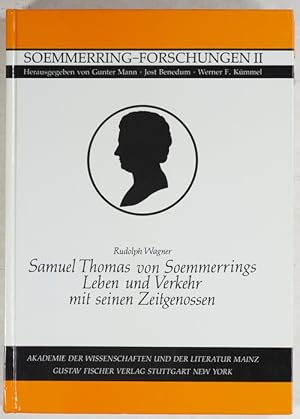
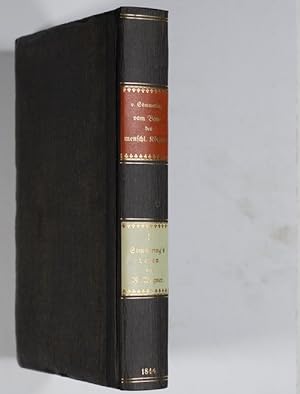
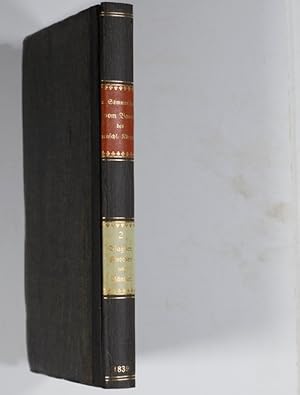
![Imagen del vendedor de De decussatione nervorum opticorum / [Resp.:] Franc[iscus] Nic[olaus] Noethig in Academia Moguntina (14.) Maii 1786. a la venta por Antiq. F.-D. Söhn - Medicusbooks.Com](https://pictures.abebooks.com/inventory/md/md630177873.jpg)
